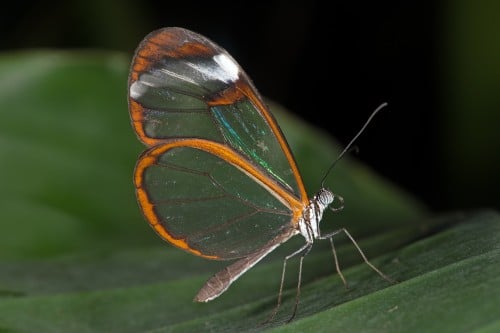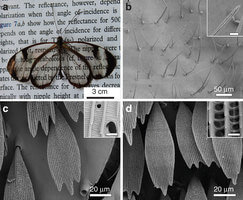The Glasswing butterfly (Greta oto), boasts wings with most of their surface area transparent, yet - they hardly reflect light. The light reflection from the wings is between 2% and 5%, depending on the viewing angle


By: Dr. Amir Becker
Who among us does not find himself fighting light reflections and/or reflections that interfere with viewing the computer screen or the phone screen? Technological solutions, such as anti-reflection coatings, usually dim the brightness of the screen and limit the viewing angle.
The Glasswing butterfly (Greta oto), boasts wings with most of their surface area transparent, yet - they hardly reflect light. The light reflection from the wings is between 2% and 5%, depending on the viewing angle. For comparison, a transparent glass surface reflects between 8% and 100% of the light falling on it. The low reflection, of course, helps the butterfly to disappear from the eyes of predators, and in this context it is interesting to note that radiation beyond the visible light frequencies, in the ultraviolet and infrared ranges, is not reflected from the butterfly's wings.
Nanometric structures on the wings of the butterfly
Researchers at the Karlsruhe Institute of Technology in Germany (KIT - Karlsruhe Institute of Technology) tried to trace the mechanism that enables such transparency, without light reflections. The results of their research, which were published in April 2015, reveal that the secret lies in the nanometric structures on the butterfly's wings, and moreover, in the irregularity of these structures. In a scanning electron microscope tiny strands were discovered, with varying lengths (400-600 nm) and varying density (distances of 100-140 nm from each other). To illustrate the size, we note that the average thickness of a human hair is 100,000 nanometers.
Using a simulation model, the researchers proved that the main reason for the very low returns in a wide range of viewing angles is the irregularity in the height and distribution of the tiny structures on the wing. As in the case of Qualcomm's Mirasol screen inspired by the morpho butterfly, the research and its results open a practical door to a series of technological applications, relating to screens with low light reflection and high readability. Preliminary feasibility tests even hinted at an unexpected side gain: it turned out that a layer of irregular nanometer structures that mimics the butterfly's wings also exhibits water and dirt repellent properties. It seems, then, that thanks to the glass wing butterfly, in the near future we will be able to enjoy a phone screen that will be not only brighter and more readable than the existing one, but also cleaner and drier than it.

One response
I liked the last sentence "...in the near future..."